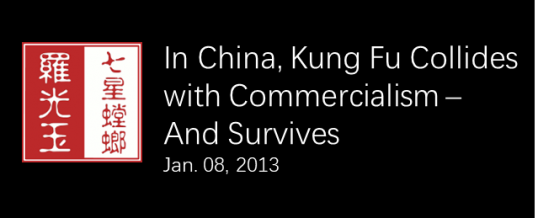
Article written by Jessica Levine. Originally published in Teaf Leaf Nation on January 8, 2013. See link here.
The early morning in Dengfeng, Henan province in Central China resonates with the thwacking of landed kicks on brick, of wind pants and tennis shoes rubbed flat from unforgiving overuse. Kung Fu students, fueled on rice porridge, are preparing for a full day of training.
As scooters pour into nearby streets, a fog peels back to reveal Shaolin Temple (少林寺) perched in the crags of Mount Song, the ancestral home to Chinese martial arts. Traveling from some of the most desolate stretches of the country, these 50,000 adherents gather outside temple walls to embrace all that is 21st century Kung Fu: The place where tradition meets Bruce Lee, where the fundamentals of speed, balance, and patience fuse with kickass swagger.
“While Kung Fu isn’t necessarily religious, there are a lot of roots in Daoism and Buddhism,” explained Gene Ching, associate publisher of Kung Fu Tai Chi Magazine, in an interview with Tea Leaf Nation. “A lot of things bleed into a lot of other things. It’s like a great Chinese banquet, where there are so many different kinds of dishes.”
Indeed, Kung Fu is about more than faith and combat. It also exists with one eye towards the market, as evidenced by the popularity of training schools, films, novels, and live performances worldwide. Shaolin—itself a crush of old and new, a relic from the first century, seized in the 1950s during Communist land redistributions—lies at the enterprise’s pinnacle. With annual revenue of a “few dozen million Renminbi” from selling souvenir soap and tickets to Kung Fu skits, The Financial Times deemed Shaolin “one of the most famous global brands to have come out of China in any industry.”
But Ching does not feel that Kung Fu’s commercial bent undermines the art’s identity. “When you have something that’s been a tourist site for twice the length of the existence of the United States, you have to stand back and give pause in terms of how you’re defining tradition versus commerce,” he said. “Religious sites have been pilgrimage sites from the onset. There’s this fantasy that Shaolin should be this desolate temple way up in the mountains, that you have to undertake this great to trek to reach it.”
While journeys through golden forests resemble mythical thinking more than practical reality, the Chinese have retained their affinity for the stories surrounding their martial arts. In We Pictures’ 2011 thriller “Dragon,” Yen portrays a paper-mill worker and kung fu vigilante during the post-Qing Dynasty—a film considered a “roaring” success on the Mainland.
To hear long-time Kung Fu masters tell it, the real threat to their art is not commerce, but other martial arts lacking Kung Fu’s quintessence. “Right now, Chinese martial arts are being challenged by mixed martial arts—because mixed martial arts (MMA) strips it all down, takes that culture out, and reduces it to fighting in the cage,” Ching said. Paradoxically, Kung Fu’s wide entertainment appeal has opened the door for other martial arts that might supplant it.
Proof positive is the surge of the Ultimate Fighting Championship, which held its first MMA show in Macao in November to a sold-out audience. A search for the acronym “UFC” on Sina Weibo, China’s Twitter, generated hundreds of thousands of results. Weibo user @搏击赛事推广人方升 breathlessly wrote, “True warriors; we should pay tribute to them. No matter whether they win or lose, they shake our hearts; hope there will be more Chinese boxers who can enter the UFC ring!”
Indeed, while China has harnessed the pop culture of Big Macs, Gucci, and the Internet, it does hold semblances of Kung Fu tradition. Today, however, those traditions are echoed anew—to, say, a funky cover of a disco classic in honor of our favorite high-flying, animated panda.
Welcome to 21st century Kung Fu.
JAN
2018
